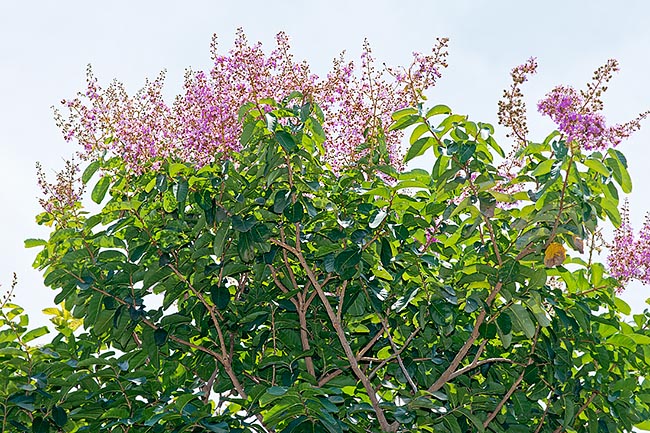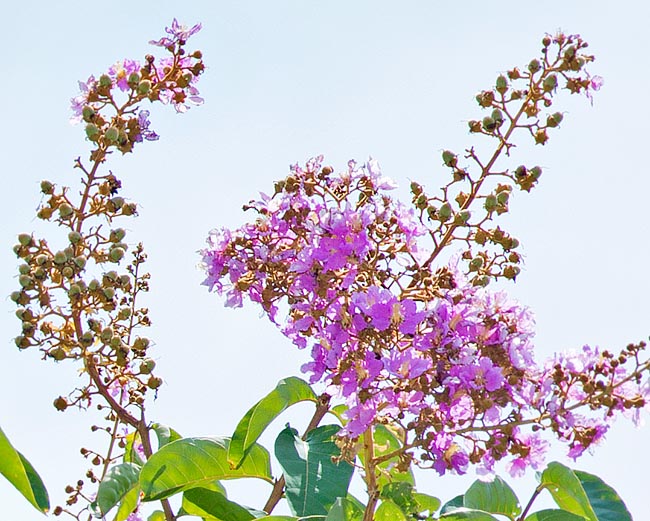Family : Lythraceae

Text © Pietro Puccio

English translation by Mario Beltramini

Native to Cambodia, Laos, Thailand and Vietnam, Lagerstroemia calyculata may be 25 m tall. Slow growth but easy cultivation in the tropics as ornamental plant in parks and gardens and as road tree © Giuseppe Mazza
The species is native to the deciduous and semi-deciduous forests of Cambodia, Laos, Thailand and Vietnam where often is one of the dominant species, at low altitudes.
The genus was dedicated by Linnaeus to his friend, Magnus Lagerström (1691-1759) who was director of the Swedish East India Company; the specific name is the Latin adjective “calyculatus, a, um” = provided of calyculus (epicalyx), bracts placed immediately under the calyx.
Common names: queen’s flower (English); sralao (Khmer); puay, puuay (Lao); mai ta bek, ta baek (Thai); bằng lăng ổi, sang lẻ, thao lao (Vietnamese).
The Lagerstroemia calyculata Kurz (1872) is an evergreen or semi-deciduous tree, up to about 25 m tall, with trunk, up to 50 cm of diameter, irregularly waved, with grey-brown bark tending to flake.
The leaves, on a 0,5-1 cm long petiole, are opposite, simple, oblong with pointed apex and entire margin, 8-18 cm long and 3-5 cm broad, glabrous above, pubescent below.
Terminal panicle tomentose inflorescences, 10-20 cm long, carrying numerous hermaphroditic sessile or sub-sessile flowers with campanulated calyx, about 0,5 cm long and covered by yellowish tomentum, with 6 triangular lobes having pointed apex.

Terminal panicle inflorescences, 10-20 cm long. Corolla with 6 unguiculate petals. The bark, rich of tannins, alkaloids, flavonoids and other bioactive compounds, is used in traditional medicine for various pathologies © Giuseppe Mazza
Corolla with 6 unguiculate petals (petals with long narrow base similar to a stem) with obovate edge with wavy margins, white or pale violet, 0,5-0,8 cm long and numerous stamina.
The fruits are blackish oblong capsules, 0,7-1,2 cm long and 0,6 cm of diameter, with persistent calyx, usually containing 6 dark brown seeds.
It reproduces by seed, in organic loam maintained humid at the temperature of 24-26 °C, and by cutting.
Species of easy cultivation and slow growth utilized, in particular in the origin countries, also as ornamental plant in parks and gardens and as road tree, cultivable exclusively in the tropical and subtropical climate zones, not bearing temperatures around the 0 °C, if not exceptional and of short duration and with serious damage to the aerial part.
It requires an exposition in full sun or partially shaded and is not particular about the soil, provided draining, preferably acidic.
The wood, of average quality, hard and heavy, but not very weather resistant, is utilized in the civil constructions, for floors, partition walls and internal parts in general, in the naval furnishing, for furniture, agricultural tools, handicrafts and locally as fuel.
The bark, rich of tannins, alkaloids, flavonoids and other bioactive compounds, is utilized in the traditional medicine for various pathologies.
Synonyms: Murtughas calyculata Kuntze (1891).
→ To appreciate the biodiversity within LYTHRACEAE family please click here.
